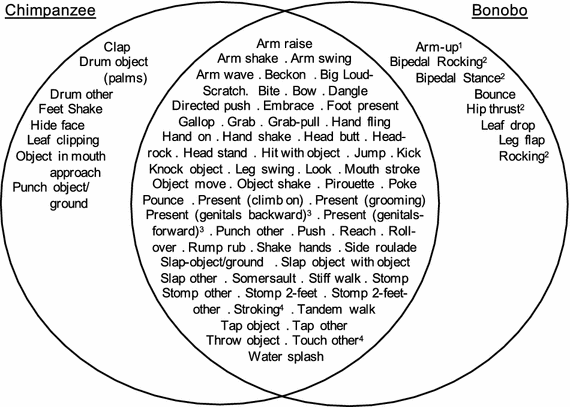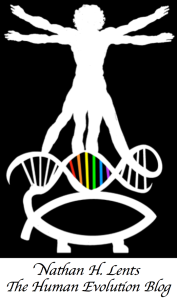The Bonobo, also called pygmy chimpanzee, is the oft-forgotten human relative, the step-brother of its more famous kin, the common chimpanzee. This is understandable because bonobos are isolated to one small region of the Congo and number fewer than 40,000 individuals spread across only a handful of populations. Common chimps, on the other hand, are spread widely across the rainforests of equatorial Africa and number upwards of 300,000. Both chimp species are endangered, primarily due to habitat loss and poaching.

Humans are equally related to bonobos and common chimpanzees, sharing a common ancestor that lived around 7 million years ago. The two chimp species diverged from each other much later, just 1.5 million years ago, probably due to the isolation of the future bonobo population by the Congo river. (Neither chimp species are natural swimmers.)
In that time, the two chimp species have evolved interesting anatomical and behavioral differences, perhaps the most interesting of which are the gendered social behaviors. Common chimps employ a highly aggressive, patriarchal dominance hierarchy, while bonobos live in matriarchal social groups marked by less intra-group aggression and more affectionate and sexual contact among group members. If common chimps are fighters, bonobos are lovers. (It’s not actually that cut and dry, but you get the point.)

Anthropologists and primatologists are particularly interested in how chimpanzees communicate with each other. Given that these are our closest relatives, research on chimpanzee communication can be a window into the evolution of human language.
The most striking feature of communication among both species of chimpanzees is that it is primarily nonverbal. While both species are vocal and quite noisy about it, the calls are not classified as true referential communication because they don’t appear to have unambiguous meanings. For example, the most easily recognized chimpanzee call, the “pant-hoot” first fully described by Jane Goodall, can mean a variety of things in different contexts. It’s mostly just a way to get someone’s attention and/or register anger, threat, surprise, or delight. Context and facial expressions are needed to clarify the meaning. So these calls are not really words. They are not “referential communication” in the lingo of specialists, because they do not refer to anything specific in the listener’s mind.

Nonverbal communication in chimpanzees, however, can be clear and precise. What we are talking about is gestures or body language. We have long known that apes are capable of sign language, and I have summarized the three most well-known “talking apes” in this post. But the more interesting question is whether apes use gestural communication naturally.
While much of this work has been done with apes in captivity, in 2011, researchers published an exhaustive study of gestural communication in wild chimpanzees. In that study, Catherine Hobaiter and Richard Byrne reported over four thousand instances of body language over 18 months time. Most intriguingly, they were able to identify and codify 66 specific chimpanzee gestures that are used regularly in the wild. Each of these have stable meanings in a given context and were understood by the receiver of the gesture.

The meanings of chimpanzee gestures include mundane things like, “stop that” and “move away,” but also more complex messages such as, “follow me” and “please groom me.” The researchers used strict criteria for determining whether a gesture was a bona fide communiqué that centered around whether the recipient understood the meaning and reacted accordingly. What good is it to communicate if no one understands what you are trying to say?
This month, Professor Byrne and colleagues announced a similar study, but this time focusing on bonobos. While many papers have examined possible body language in bonobos, most have focused on bonobos in captivity and none has painstakingly gathered evidence that the gestures were correctly understood. In closing this loop, Byrne and colleagues have made great strides toward understanding how bonobos communicate complex ideas with each other.
Some bonobos gestures are relatively straight-forward such as beckon, push, stomp, and climb on (an invitation from parent to child). Others are more interesting such as Side roulade, when the signaler rolls around on the ground, and present-sexual in which the signal expresses a sexual invitation and can be given in either the genitals-forward or the rump-forward orientation.
Even more surprising than the large repertoire of clear bonobo body language is how much that language overlaps with that of common chimpanzees. Byrne and colleagues detected 68 clearly understood gestures in wild bonobos, and 66 in common chimps back in 2011. 60 of these gestures overlap between two. That 88% of the gesture repertoire overlaps between bonobo and chimpanzee is strong evidence for some form of biological-genetic underpinnings for the gesture themselves, not just the instinct and ability to make them.

As Professor Byrne told me, “[there is] not much data on bonobos, but lots on chimpanzees: and it all points to virtually the same gestural repertoire at all sites, and captivity. The repertoire of Budongo (Uganda) chimpanzees included every gesture seen at Gombe (Tanzania), almost all seen at Mahale (Tanzania), and the vast majority of those seen at Bossou (Guinea).”
To offer a contrast: all Indo-European languages trace their roots to a parent language called proto-Indo-European (PIE), spoken by a mysterious people living in the steppes of central Asia in the neolithic age. In just 5000 years time, descendants of PIE speak such diverse languages as Punjabi and Portuguese, which are 100% mutually-unintelligible. Even German and English, which share much more recent roots, have diverged sufficiently to make them completely distinct. This is because the language wiring in our brains doesn’t encode specific words or even grammar. We have a language instinct, but the language itself develops and evolves culturally, not biologically.

Such striking overlap in the gestures of bonobos and common chimps despite more than a million years of separate evolution (200 times longer than Punjabi and Portuguese speakers have been separate) argues for some form of innate programming for the gestures themselves, not just the general instinct to use them.
In fact, there is considerable overlap between these chimpanzee gestures and the gestures used by gorillas and orangutans. There are at least 24 known gestures that are used in all great apes (and Prof. Byrne told me that he has a paper in press that will raise this number to 36), implying that the body language of hominids has roots that are at least 12 million years old.
For this reason, many anthropologists see gestures as the original basis of human language. Here are some some lines of evidence for that theory:
First, our vocal anatomy only recently evolved to support speech as we currently know it. Yet, our lineage had been communicating with gestures for many millions of years, as evidenced by gestural communication we see in our ape cousins. Therefore, it seems likely that the first human languages were body languages, not vocal ones.
Secondly, human babies attempt to communicate with gestures before they attempt words. I am speaking of attempts at referential communication, not just cries or other generic efforts to draw attention. Some gestures are simple, such as reaching for things, while others are more sophisticated pantomimes.
Thirdly, pretty much everyone in all cultures peppers their speech with gestures and hand motions. In fact, most people will use gestures while practicing a speech without an audience or while talking to an audience of blind listeners. We just do it. It’s unconscious and very difficult to stop. Even more telling, the hand motions that accompany speech are remarkably universal around the globe. While our spoken languages evolve rapidly, our gestures do not appear to.
Fourthly, human children born blind will attempt to communicate with gestures on pretty much the same time-scale as sighted children and they continue to use gestures when they start speaking. Of course blind humans use gestures much less, since this form of communication does not get practiced and reinforced. Nevertheless, that they use them at all argues that gestural communication is biologically programmed in humans, just as it is in our fellow apes.
Fifthly, animals as distantly related as old-world monkeys have been observed to invent new gestures to facilitate social communication, as I’ve written about here.
The study of the rich gestural repertoire of bonobos adds further weight to the theory that humans first found our voice through body language. As so often happens when we study our fellow animals, we learn something about ourselves. After all, we are not so different.
-NHL

Made me laugh great post!
LikeLike